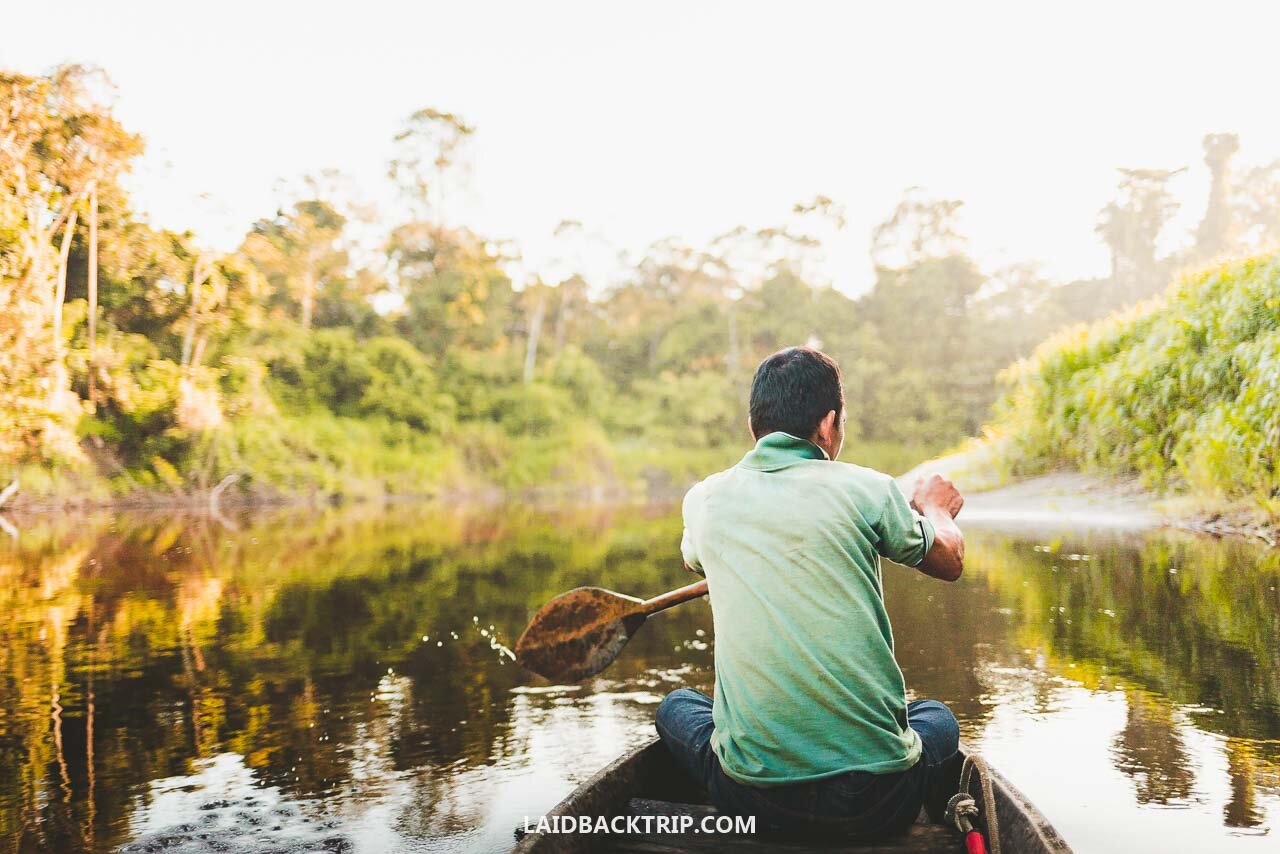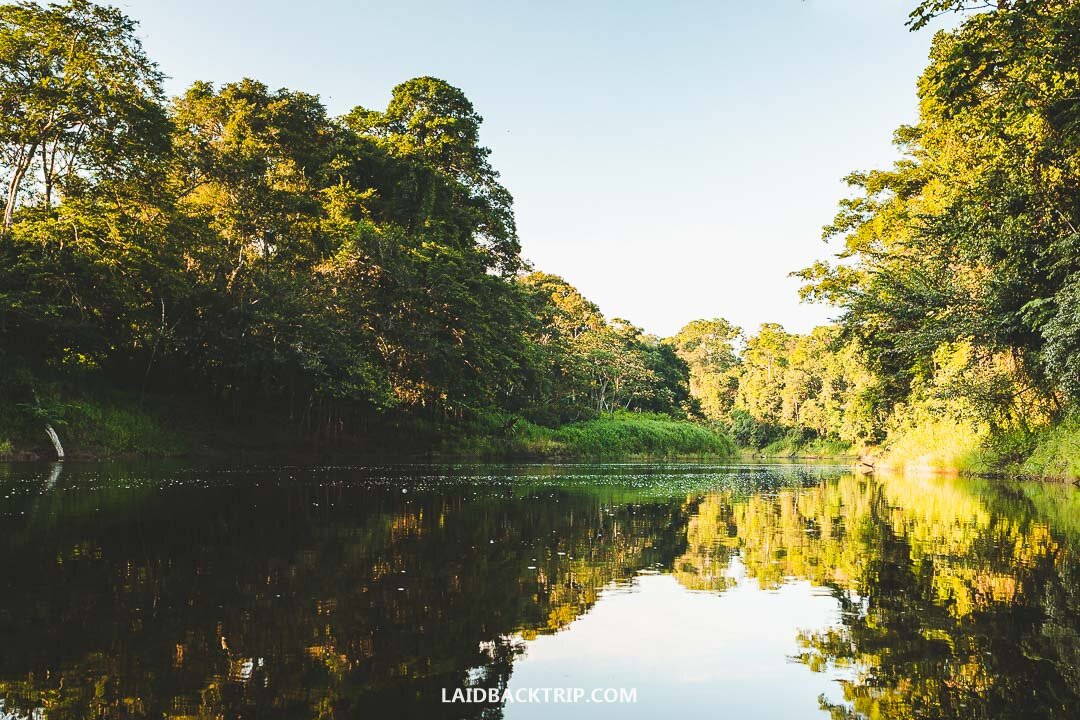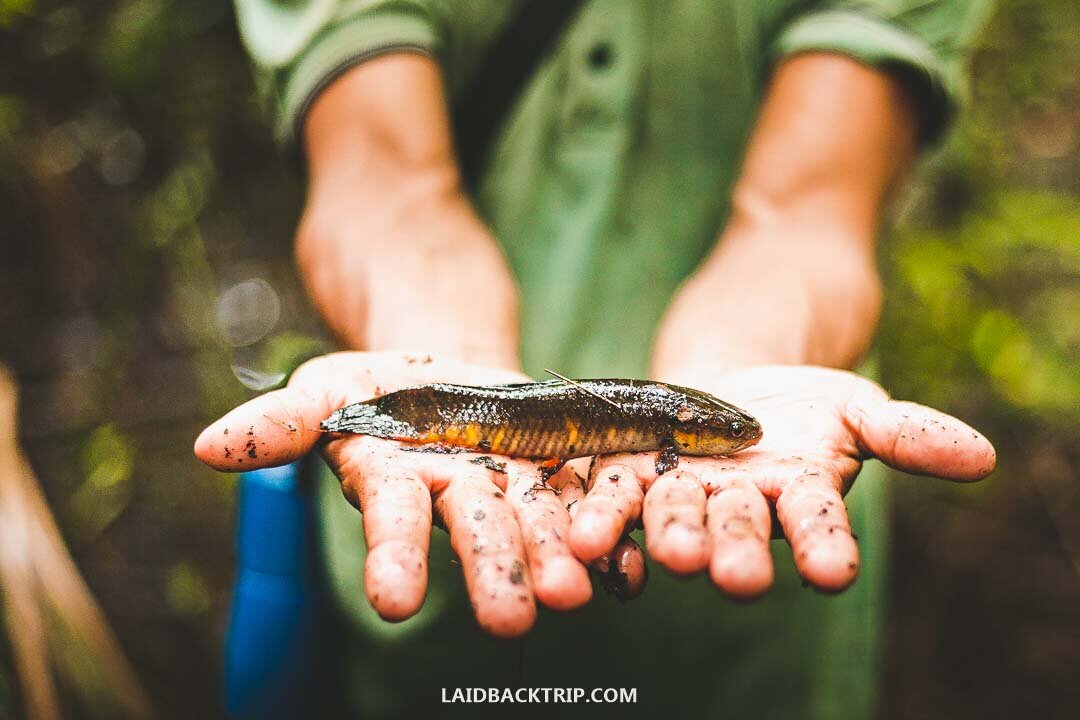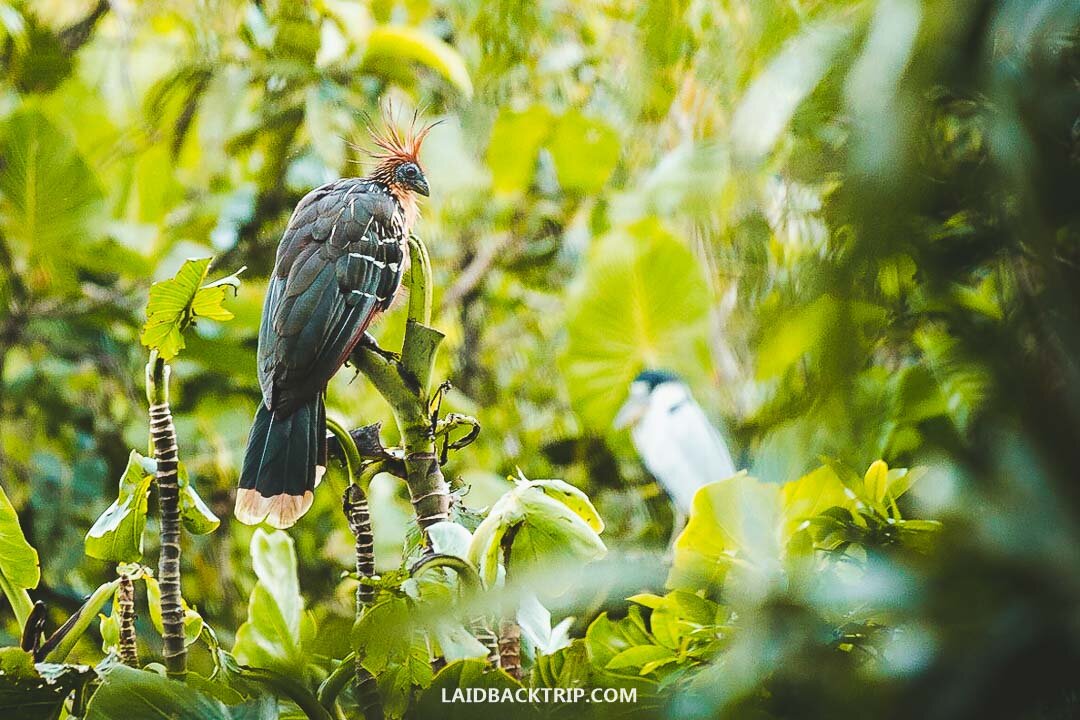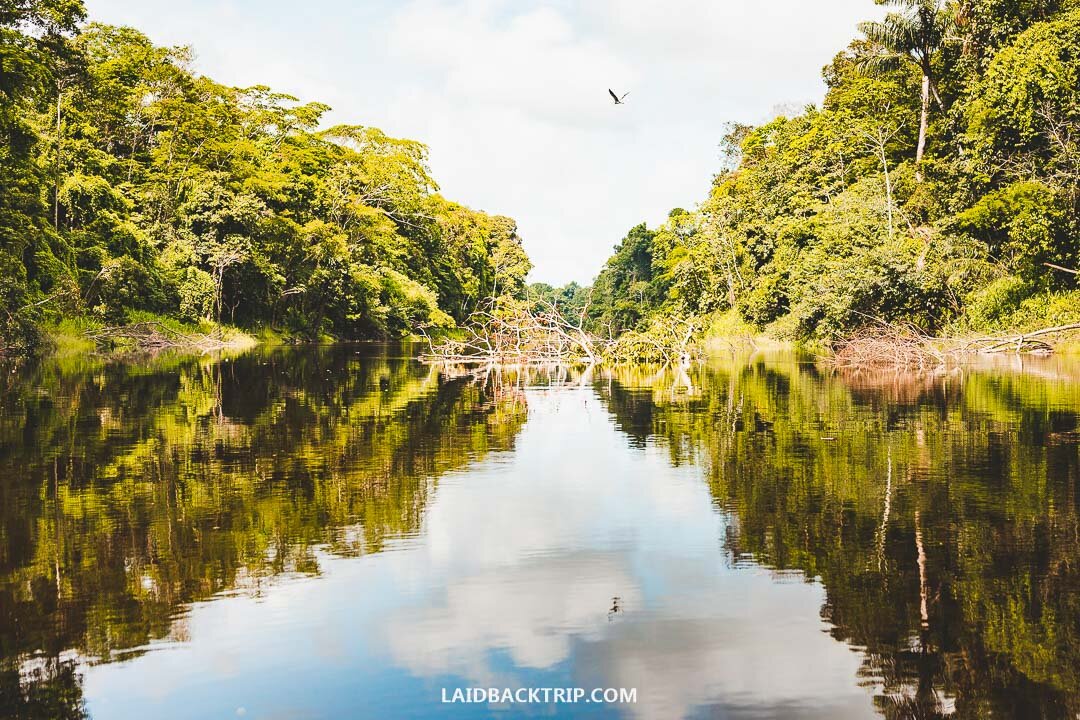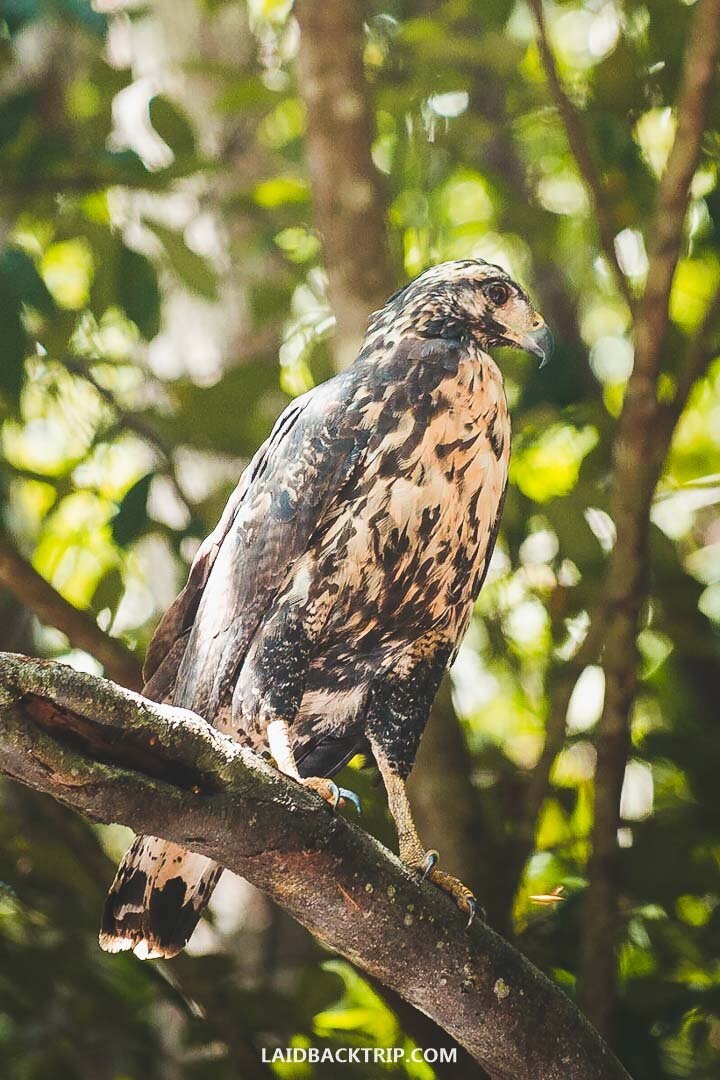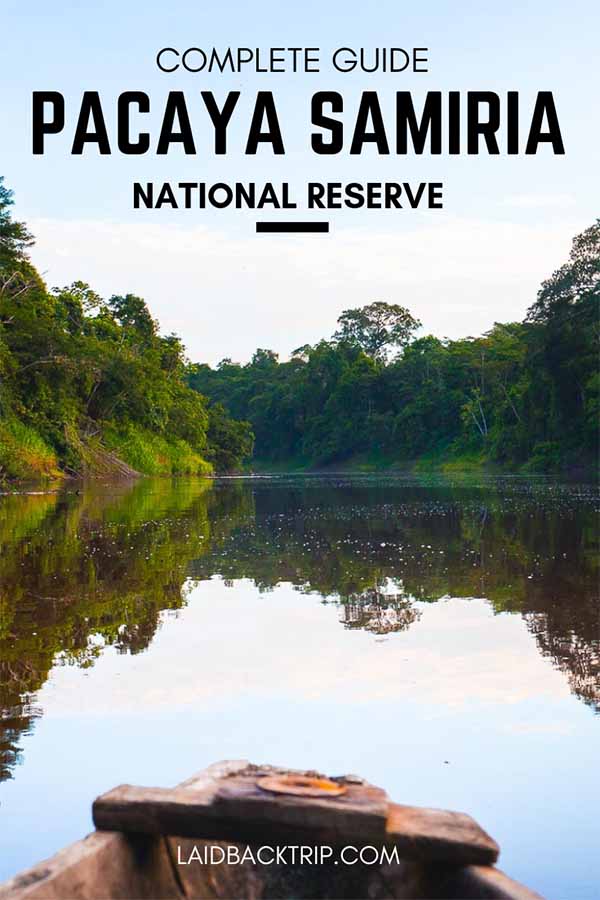Ultimate Guide to Pacaya Samiria National Reserve, Peru
Read our travel guide on camping in Pacaya Samiria National Reserve, Peru. We share tips on how to visit Amazon in Peru and how to get to Pacaya Samiria from Iquitos, what to see, activities, wildlife, how to choose the best tour, where to stay, what to pack, when to visit, how many days you need, and things to know.
Our one-week trip to the Amazon jungle in Pacaya Samiria in Peru was not a typical relaxing travel experience.
Sweat was pouring down our faces almost constantly for seven days and six nights. No wonder when the outside temperature was exceeding 35°C every day, the humidity was out of the roof (and it was not much better at night).
And the entire time, we had to wear long-sleeved t-shirts and long trousers to protect ourselves from obtrusive mosquitos and other insects, sticker plants, and other things we didn't even want to think about. It wasn't charming, to put it mildly.
But when we arrived back to Iquitos, our base for visiting the Amazon in Peru, after seven days without a proper shower, after a week sleeping in a tent, when we cleaned our clothes from the last stains of mud, took a shower and I removed a tropical tick from my leg, we agreed that seven days camping in Pacaya Samiria National Reserve in Peru was one of the best things we've ever done.
Pacaya Samiria National Reserve gave us exactly the experience we were looking for.
A week packed with adventures, wildlife spotting, insight into local life, authenticity, all of that far from anything that would even remotely reminded us that we are in one of the most touristy destinations in South America.
Although more and more travelers visit the Amazon every year, we decided to go one step further.
As we traveled long term at the time, our Peru itinerary was quite flexible. Traditional two or three-night Pacaya Samiria tours involving sleeping in a lodge and making a couple of day trips seemed to us a bit short.
In the end, we had opted for a seven-day camping Amazon adventure from Iquitos.
As it is not that common to spend that long in the jungle and not to sleep in a lodge, it led us to the idea to share our experience in this blog post.
We believe that meeting indigenous people and exploring the unique environment slowly is one of the environmental-friendly travel styles that have a future.
This blog post includes the complete Pacaya Samiria National Reserve travel guide, where we share everything you need to know before you go and much more.
AMAZON RAINFOREST
The Amazon Rainforest or the Amazon Jungle is an area in South America covering about 7,000,000 square kilometers, and the rainforest grows in most of the Amazon basin.
As you can see, the size doesn't help when you want to make a quick decision about which part of the Amazon to visit and how.
Although most of the rainforest is within Brazil, we decided to travel to the jungle in Peru, which is with 13% of the rainforest in second place and belongs among the most biologically diverse areas on the planet.
If you think of Peru only as about a country of beautiful blue lakes, towering peaks, mysterious Nazca lines, deep canyons, Inca trail and Machu Picchu, you might be surprised that the Amazon region comprises 60% of the country, even though for many it is still not a reason to visit the area while in Peru which is quite understandable.
The trip can be time-consuming as you need to drive long distances or take a flight.
Still, we would like to show you the example of visiting Pacaya Samiria to inspire you that both your time and money will be, in this very case, well worth it.
And because the Amazon River has its source in Peru, in the mountains near the famous Colca Canyon, it is another reason to travel here.
PACAYA SAMIRIA NATIONAL RESERVE
One of the largest protected areas in Peru in the Loreto region caught our attention right after we started planning our Peru itinerary.
It seemed untouched, not that heavily visited. We couldn't find much information about it, and we instantly knew that it is the place where we want to experience the Amazon. Pacaya Samiria is also home to many animal species and a large number of plants (very often medicinal), which we were hoping to see.
Very soon, we learned that this experience would be completely different from the one we've had on the Galapagos Islands, where it seemed that animals are waiting for us to take a perfect shot.
But more about it later.
Pacaya Samiria is also nicknamed jungle of the mirrors thanks to the beautiful reflections of trees on the water surface, and we can confirm the area did not get this name by mistake.
There are a few ways how to visit Pacaya Samiria, but one thing is for everyone the same.
No one can (legally) enter the Pacaya Samiria reserve without a guide. When choosing a travel company or a guide, make sure they have a license to operate within the area as only several companies can enter the reserve.
The best way to find out is to visit an official visitor center in Iquitos, where they have a list with all companies who have permission to access Pacaya Samiria.
If you want to book the trip in advance, ask for the itinerary and check out whether the places on the schedule are really within the reserve and you won't be only encircling its borders.
We've heard a few stories when guides took clients only around the reserve's borders but did not enter it.
There is an official checkpoint in Santo Domingo about 3 hours by boat from Nauta, where you will get off the vessel, the guide should pay here your entrance fee, and you must sign in by writing down your name and details into the book.
HOW MANY DAYS YOU NEED
How many days do you need to explore Pacaya Samiria National Reserve? You can spend here anything from one day to several months; it only depends on how limited your time and funds are!
We wouldn't bother coming only for one day unless you want to tick off another destination from your list.
If your time is that limited, there are other destinations in the Amazonas region or on the very edge of the Amazonas region, such as Chachapoyas, from where it is possible to get the sense of what the area has to offer, and you do not have to travel that far. Plus, tours will be cheaper which is always great for budget travelers.
Even though three days might sound like a reasonable amount of time, don't forget that you won't do much on the first and the last day because you need to get to the reserve first (and back), which is quite time-consuming.
For example, on the first day, we had to wait for our guides to buy supplies on the market and the drive from Iquitos to the port also took some time. Then we traveled by boat for a couple of hours to the entrance of Pacaya Samiria.
From our experience, anything between five to seven days should give you an idea about Amazon and also guarantee you plenty of chances to spot wildlife.
We found one week to be just the right fit. The days were not the same, and we saw new species or did different activities every day. But again, if you are short on time, five days in the Amazon should be fine as well.
We would recommend staying in the jungle for over a week (especially on a camping trip) to more adventurous souls for one reason.
No matter how awesome the experience is, it is also quite challenging - there's no place to take a shower (except for swimming in the water), you will be sweaty, there's also no proper toilet, and to sum it up, it is not very comfortable, so after seven days, we were really looking forward to taking a proper shower and sleep in a bed.
HOW TO VISIT PACAYA SAMIRIA
There are several ways how to visit Pacaya Samiria Reserve or rather how to spend your time there.
To get in Pacaya Samiria National Reserve, you must take a tour that includes camping or sleeping in the villages within its boundaries. Of course, the tour includes transport that consists of car drive to the port and then boat trip depending on your itinerary.
In general, you have two options on how to visit Pacaya Samiria.
The first option is staying in a private lodge - that usually means the lodge is not in reserve, but you'll be taking trips to the reserve with a guide.
It is important to check the conditions because some stays in lodges include only the program that takes place on their property. No matter how their gardens are stunning and full of life, it is necessary to know this is what you are looking for.
Another alternative, the one we opted for, was to book a boat tour to Pacaya Samiria with arranged accommodation within the park. That usually includes a mix of sleeping in campsites or a native guide's house in the village within the park.
The last option on how to visit the reserve is the most expensive one.
You can take a cruise, but same as with staying in the lodge, you should know that no big ship is allowed to enter the reserve, so you will only be able to visit the Pacaya Samiria during one-day boat trips, but you will have to return before the park closes.
BEST TIME TO VISIT PACAYA SAMIRIA & AMAZON
There are generally two seasons in the Amazonas - dry and rainy. In Peru, the dry season lasts from May to October, while the rainy season begins in November and ends in late April.
Of course, it won't start raining exactly on November 1st, but there is a higher chance of getting wet, especially during the afternoons. Because of the heavier rains for six months, the water is culminating, and the highest level of water in the river is in May.
We visited Pacaya Samiria at the end of the dry season, in late October, and we still could see marks on trees proving how high was the water last year - more than 3 to 5 meters higher than when we visited the area!
Arguably, the best time to visit the Amazon is in July and August. The height of water in the jungle is reasonable, and you have a high chance of spotting wildlife.
Although every season has its advantages and disadvantages, you should make sure you know what to expect and what you want to see in the jungle; the flora altogether with a chance of spotting animals changes throughout the year.
When the water level is high, hiking is limited to smaller areas (you will spend more time on the boat or canoe, which was one of our most favorite activities, by the way), it can be a bit harder to find some species of animals, but you will be closer to birds and monkeys hiding on treetops.
The biggest downside of traveling in the wet season are omnipresent mosquitos.
On the other hand, in the dry season, it can happen that all waterways won't be navigable (we recommend hiring a smaller boat to increase your chances for passing). Still, there are fewer mosquitos, better fishing and hiking opportunities.
Based on our experience, we could not choose a better time for traveling to Pacaya Samiria in late October.
We saw many animal species, enjoyed times on the boat, and when exploring the jungle on foot, it rained only a couple of times at night, and overall this season delivered what we expected.
Temperatures in both seasons don't differ much it's hot and humid throughout the year.
IQUITOS
Iquitos is the world's largest city, which cannot be reached by road. Apart from this fact, it is mostly an unappealing city that serves only as a gateway to the Amazon for those who want to experience the jungle.
Lately, it became a meeting point for people with no interest in nature or wildlife - for people who arrive here to try the indigenous psychedelic plant Ayahuasca. We are not fans of drugs, so we skip this topic entirely. Just remember, using drugs, especially in an unfamiliar environment, might not be the smartest idea.
Not to mention that the Ayahuasca ritual became a profitable business in Iquitos, and you can never be sure about the quality and people who prepare the drink for you.
Iquitos is connected by road only with Nauta, a small port town where we started our Amazon journey.
It is about two hours drive from Iquitos, and in case you are looking only for one day trip, the cheapest way is to arrive in Nauta on your own and go to the port where you can find a boat driver without using an agent.
There are not many things to do in Iquitos except for strolling around the riverfront and the main square; this is why we used it solely as a base for visiting the Amazon.
WHERE TO STAY IN IQUITOS
Iquitos has a very compact city center with many hotels, restaurants, and travel agencies around the main square.
So everything is close, and you don't need to worry about anything but finding the right tour agency for your Pacaya Samiria Amazon adventure.
We've handpicked the best hotels in Iquitos for every budget category.
Budget | Hospedaje Neydita - Family-like environment, clean facilities, private rooms close to the main square, and free wifi are the main features here.
Mid-range | Central Bed and Breakfast - This new hotel provides high-quality service. The staff speaks English and Spanish, and you will find here much-needed air-conditioning, especially after your adventure in the jungle.
Luxury | Doubletree by Hilton Iquitos - A wonderful hotel right on the main plaza with spacious rooms and a beautiful outdoor swimming pool.
HOW TO CHOOSE THE BEST TRAVEL AGENCY IN IQUITOS
Honestly, we don't have the correct answer because even though our tour in Pacaya Samiria was great, the travel agency could have done some things better. However, there are a few basic steps you can follow to make sure your trip will go smoothly.
Before arriving in Iquitos, do online research, and select several travel agencies you like based on their websites, itineraries, and reviews.
Once you arrive in Iquitos, try to visit all of them and compare the price they will offer you and take into account the feeling you have from the presentation and the office staff.
Unfortunately, a few times we had a feeling that people want our money (which is understandable) but don't realize they should provide us with the corresponding service we pay for. This is not just the case of Peru, but some other countries as well.
If you are looking just for a day trip from Iquitos to the Amazon rainforest, your selection process doesn’t have to be so rigorous, but the extra effort is worth it for multi-day tours.
As we wanted to learn as much as possible about the Amazon and were not fluent in Spanish, we really put effort into the search. If you need an English speaking guide, ask the manager to meet him in advance (although keep in mind that there can always be a last-minute change in staffing).
As there were not many tourists in Iquitos at the time of our visit, we very quickly became wanted customers in Iquitos. The reason was simple.
The majority of travelers visit Pacaya Samiria for two or three days. Because we wanted to spend seven days there, everyone was more than interested in having us. We visited several offices, and later we were even followed by companies' employees because they wanted to know where we go next.
We recommend you not book a tour via website or email unless it's a reliable travel agency.
Not only the online price is always the most expensive, but you won't be able to make a decision based on your feelings. Usually, the tour cost around $100 per person per day.
One company (we eventually did not go with) offered us the lowest price of $55 per day. Still, because we were not sure about the guide's English level, we finally decided to go with a travel agency that seemed more trustworthy for $70.
Bargain, but always remember you will get a service you paid for. If you bargain too hard, you might end up, for example, with just one guide instead of two, or your guide will also be your cook, etc. So, as a result, you will spend less time exploring the jungle.
You don't need to worry that you won't find a tour available as departures are daily from Iquitos.
There should be a minimum of two people, but if you travel on your own, try to ask around and find fellow travelers or be prepared to pay a bit more.
WHAT'S INCLUDED IN THE PRICE
Before paying in full, always ensure that you won't need to pay anything extra during your trip.
What should be usually included in the price: transport from and to Iquitos, boat, fuel, guides, boat driver, food, drinking water, camping equipment, accommodation, rubber boots (came in useful), canoe. We only took our mosquito net, mosquito repellent, sunscreen, sunglasses, and clothes.
The food on tour is simple but satisfactory. Breakfast consists of toast (we wouldn't buy the cheapest one, though), jam, eggs, fruits, and coffee or tea. Lunch and dinner was usually rice, potatoes, vegetables, and fish or meat.
What we would always appreciate is to have tips included in the price. Tipping guides is not very comfortable for us (it is probably a cultural thing), but it’s a common things in South America, and it was the same on Galapagos Islands Cruise or Salar de Uyuni Tour.
We would really appreciate it if the tips were included, on the other hand, we can appraise good service and tipped the local guides, who always went the extra mile to make our trip memorable (so make sure to bring some cash).
LOCAL GUIDES
It brings us to guides. On our trip, we had two guides and one boat driver/cook. Although we were afraid that it would be awkward that it's only two of us and three crew members, in the end, everything was fine and very relaxed.
The leading guide spoke English well, and in Buenos Aires, a small settlement where we spent our first night, another guide joined us.
At first, we were a bit skeptical about the non-English speaking guide in our team, but he turned out to be our favorite member.
Because he lives all his life in Amazon, he knew a lot about flora and fauna, was able to spot and hear wildlife on a long-distance, could catch some animals with his bare hands (he released them later), and overall passed on a lot of valuable knowledge.
Without his impeccable eyesight and trusty machete, we wouldn't have seen that much during the whole week.
The driver/cook was a sort of behind the scenes guy who was taking care of the practical things.
Our naturalist guide was superb, knowledgeable (his family lived in the jungle for a long time), and was also able to explain even more about local life and customs of people living in the Amazon. Hearing stories from him about his life was one of the best parts of the trip.
The only issue we had was that he was not really following the itinerary we had agreed upon. We chose to go to the Amazon for seven days to get a deeper, more intense experience, and we wanted to go to places not many people visit and get a better chance to spot wildlife.
Since day two, we were behind our schedule. Each day, we were supposed to travel at least three hours by boat deeper to the jungle, but he decided to stop after traveling for an hour in the first couple of days.
On the first day, we were alright with it as we thought this place might be exceptional for some plants or animals. But when it happened the next day again, we asked the crew to carry on.
Luckily, they heard our complaints, and the rest of the tour went smoothly. It seemed they were arguing about fuel and were worried we do not have enough to travel that far, but fortunately, it all worked out well.
Also, he wanted to camp twice on the same spot (without any particular reason), but we were able to persuade him to spend a night elsewhere. A couple of times, we tried to track our journey with GPS on our phone. We were able to see our current location, but without a detailed map, it was sort of useless, and we had to trust him.
This issue was probably the only downside of our trip - we had to be more cautious about directions and travel time.
In the end, all three guides were really great, and we enjoyed the time we spent with them.
COMFORT IN THE JUNGLE - WHAT TO EXPECT
If you are thinking about visiting the Pacaya Samiria National Reserve, we only must advise that conditions are very basic.
There is no toilet and no shower.
If you want to be clean throughout your trip, you must go swimming in the river or use a canoe and a bucket (for safety reasons). Also, do not expect to have clean clothes, we recommend taking some old or not expensive clothes.
We were stuck in the knee-deep mud several times, not mentioning our clothes were clammy for most of our trip.
ACTIVITIES
Our days were busy from the morning to the evening, and we had time to rest only when we were on the boat moving from one place to another.
The best activities in Pacaya Samiria we could do during the trip were wildlife spotting, piranha fishing (some were more successful than others, Martin was rather good at catching logs), pretty demanding jungle walks (some lasted for several hours), wildlife spotting from the boat, or canoeing.
The program did not end after dusk, and we went for night walks or night canoe rides to see nocturnal animals every night.
Simply put, our itinerary was packed with activities, and there was no time for boredom.
WILDLIFE WATCHING
One of the most important things to realize before you go to the Amazon is that the jungle isn't Zoo, and wildlife is not guaranteed.
Here came our naturalist guides handy the most as we wouldn't be able to see almost anything without their well-trained eyes and ears.
Birds sit high on the branches, river turtles jump into the river once they hear a noise, and monkeys make themselves invisible in treetops once they sense you.
What wildlife did we spot in Pacaya Samiria (and sometimes were even able to take a photo of)?
Sloths, grey and pink dolphins, tarantulas, scorpions, spiders, frogs, insects, lizards, snakes (some were closer than we wanted), several kinds of ants, common squirrel monkeys, black tamarin monkeys, howler monkeys, capuchin monkeys, butterflies, Amazon hawks and other species of birds (such as camungo, macaws, hoatzins), fishes (piranas, black armor fish or small arapaima), giant otters, caymans, jaguar footprints, turtles, bats.
Certainly, we did not see every single species living in the jungle, but we saw more than enough on our first time trip to Amazon.
Probably the only animal our guide tried hard to find for us was an anaconda, but with no luck (which I did not mind, to be honest).
To get a better idea of how the wildlife spotting in the jungle looks like, we can share our experience with howler monkeys.
Howler monkeys make a loud and frightening sound we could hear when we were coming back to our campground from the jungle walk. Our guides got excited, and we were literally running behind them like silent ninjas. They were pacing quickly in front of us and cut lianas by machetes to make a passage through an impenetrable jungle.
Monkeys moved from one tree to another, and finally, we reached the river only to realize that the monkeys are on the other side. Then they stopped howling and remained silent.
We were not lucky that afternoon, but our guides were sure we would see them the next day in the morning.
We got up at 5 AM and went on a canoe to the other riverbank, but the jungle was silent. Suddenly, the howling started, and it seemed that the noise is coming from a place near our campsite.
Our guides were paddling quickly back; we jumped off the canoe and again started to follow the noise. Only this third attempt was successful.
This is how the spotting of wildlife in the Amazon can look like, and not every trip is successful. Nothing is guaranteed, but your guides will do their best (including making animal noise) to find wild animals for you.
Travel Insurance
We never leave home without travel insurance that was designed to cover our expenses if something goes wrong during the trip.
Travel insurance protects against theft, flight delays, injury, illness, cancellations, and much more.
World Nomads provides travel insurance for travelers to cover their trip essentials, including sports and adventure activities.
SafetyWing is affordable travel insurance for backpackers, long-term travelers, and digital nomads.
Travel smarter and safer!
ITINERARY
Although Pacaya Samiria is a remote Peruvian destination, it does not mean it is abandoned. The region is dotted with indigenous villages and settlements, which makes the visit even more special.
We stayed the first night in a village called Buenos Aires. It was also the only night we did not sleep in a tent but a local family house. Our local guide also lived here with his family. It was incredibly hot, and we could hear a loud frog concert all night.
We spent the second night near Arequipa village; there was a beautiful inlet full of river dolphins making puffing noises all night long.
On the third day, we arrived in Reno. A few hundred meters behind our camp was a green swamp, which is usually underwater. Apart from wildlife, we could watch a sunset from the bank.
The next day we navigated quite a long time and slept near a village called Yarina. After dinner, we were canoeing, and our guide caught more than a meter and a half long cayman with his bare hands. That’s something we will never forget.
Night canoeing became our most favorite activity. It was something we've never experienced before - to float on the river in the absolute darkness, only surrounded by impenetrable jungle, unknown sounds, and bright stars above us.
On the fifth day, we arrived at Chingana, where we met local fishers and their families, but they left before dark. Here we realized how rare this experience was. We haven't met a single tourist for five days straight!
The next day we had to start returning, and our local guide chose a spot to sleep near his home, Buenos Aires village.
The place was called Shanshal (not sure about the correct spelling), and for me, it was the nicest campground we've had so far. Near the lake where we could watch our last and the most spectacular sunset.
Before you go, make sure to also check our Eco-Friendly Travel Packing List, as you might want to reduce your environmental impact.
People along the Amazon river are deeply connected with the water and use it literally for everything. They use if for transportation, throw leftovers into the river, take a bath in it, wash their cloth (and we doubt they use biodegradable soap), wash the dishes, kids play in it, and they even drink it!
WHERE TO STAY IN THE AMAZON
Do you want to enjoy the Amazon Rainforest, yet you prefer staying in a comfortable lodge every night? No worries, we found some great accommodation options for you.
Prices in the lodges are slightly higher, but it is understandable as accommodations we've picked are in one of the most remote parts of Peru.
Budget | San Pedro Lodge - Hidden in Amazon Rainforest, this lodge is budget-friendly, yet you will have a chance to stay in an exceptional environment and watch wildlife in their natural habitat.
Mid-range | Irapay Amazon Lodge - Peaceful accommodation with breakfast and outdoor pool lies just outside Iquitos.
Luxury | Amazon Muyuna Lodge - Incredible rustic hotels three hours from Iquitos ensures you will be surrounded by animals and nature all day and night. All meals are included.
VILLAGES & COMMUNITIES
There were several inhabited villages along the route we traveled. Interestingly, some of them are named after the date locals founded those villages. Thanks to the easily memorable name, all people, even those who live in nearby villages, know when the anniversary celebration will occur.
We were in the area when one of the communities celebrated its foundation's anniversary, and it was funny to watch it.
People from settlements around arrive in the village where they celebrate for several days - sometimes for three days, sometimes for an entire week (we found it out because when we stopped in another community, it seemed empty, so we asked our guide where are everyone, and he replied that of course in the village we passed two days ago, still celebrating).
But if you think they only dance and celebrate, you're wrong. There is a serious football championship when villagers don't play only for prestige but also for money.
But of course, it wouldn't be a celebration without a local alcoholic drink. The drink is called Masato, and although we were offered to try it, we had to refuse politely.
Masato is a drink made from yuca root. Several people chew the root and then spit it into a large container. Here all the roots and saliva are mixed, and the natural fermentation starts its process (more days the fermentation takes, the stronger the drink is).
CONSERVATION AND SUSTAINABILITY
When traveling in the Amazon, we noticed several things we were not sure how to handle. Pacaya Samiria is a protected area and incredibly diverse place on earth. But it is also a region where people live for thousands of years.
It is incredibly hard to balance the impact people have on flora and fauna in the Amazon.
How do you want to explain to a person whose ancestors lived in the area since ancient times that all of a sudden, he cannot any longer hunt monkeys or fish as he is used to?
A few years ago, the Peruvian government stepped in and established some ground rules. Local people now can hunt and fish only a specific amount of fish or other species and cut wood in the jungle only when they need to build a new house. They are also involved in the conservation, and hopefully their efforts pay off.
And now there is another factor, a booming tourism industry, that brings plenty of negative aspects into the game as well, that’s why being a responsible traveler is so important.
It will take time, and we know it must be hard for people living in the Amazon to understand all those changes. Hopefully, we all will support conservation efforts and believe that it is only a matter of time before things are sorted out.
A beautiful place like Amazon deserves it.
WHAT TO PACK FOR CAMPING
Camping in Pacaya Samiria can be challenging. It is hot and humid all the time, but on the other hand, you must be covered because of the annoying mosquitos.
We recommend you not pack anything fancy, rather functional clothes and boots that will protect you all the time.
Here are a few essentials you should not forget at home.
It should come without saying, but functional underwear and socks are essential because you'll be sweating a lot. Merino products are perfect for these kinds of trips as the clothes do not smell bad even after several days.
When it comes to socks, buy higher socks because you will be wearing boots or gumboots all the time. A long-sleeved t-shirt or a thin shirt together with hiking trousers are a must.
Items you should certainly have in your backpack (check out this waterproof dry bag) are sunscreen with high SPF, sun hat, sunglasses, and bug repellent. We reapplied it multiple times a day, so come prepared.
Rubber boots are essential, but if you do not have them, it is possible to rent them in Iquitos or use your hiking boots. It can rain any time in the jungle, so rain poncho is also a must-have.
When it comes to the gear, we recommend you to bring a power bank, outdoor watch, binoculars, camera, and telephoto lens.
As we traveled long term we couldn't bring anything big or heavy. However, our 70-300mm lens on a full-frame body was sometimes not enough. If you are photo enthusiast, you really need that extra reach.
This Canon 100-500mm telephoto lens is one of the best ones for the money.
Although our rental tent was in good condition, we were glad we brought our own mosquito net, so we felt safer with the double protection.
We did not need a sleeping bag as it was way too hot, but we took cocoon, which we usually use in hostels anyway.
Other essentials are a headlamp, dry sacks to keep your valuables safe, your standard hygiene bag (biodegradable soap), toilet paper, and pills. Although we were told in Iquitos that there is a low risk of malaria, we used antimalarial pills.
Travel Resources
Here you can find links to all the travel resources we use and which you might find helpful when planning your next holiday.
Accommodation: When looking for accommodation, we usually search hotels via Booking.com or Hostelworld.
Tours: Although we love to travel independently, some places are better to visit with a guided tour.
We prefer GetYourGuide for its easy-to-use interface and solid reputation. Another great alternative is Viator.
Rental Cars: When going on a road trip, we always use Rentalcars.com, a reliable site for booking a rental car in advance.
Flight Tickets: When looking for flight tickets, you can search Skyscanner to find the best price.
Travel Insurance: World Nomads and SafetyWing cover against risks of travel.
